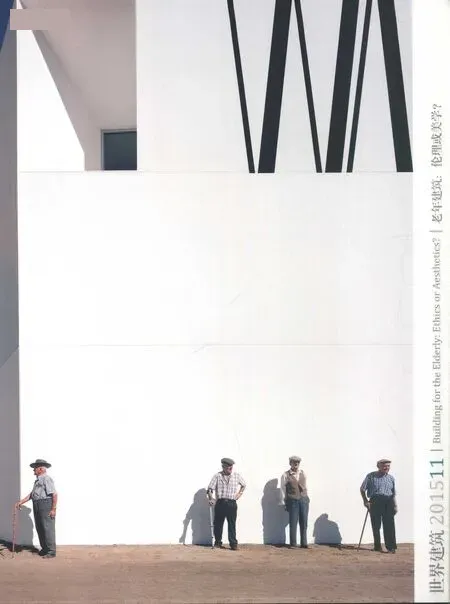为老年人的建筑:在伦理与美学之间
张利/ZHANG Li
为老年人的建筑:在伦理与美学之间
Buildings for the Elderly: between Ethics and Aesthetics
张利/ZHANG Li
刚刚公布的国家计划生育政策调整显然是针对一个事实——中国正在进入老龄化的社会。与老龄化社会的预期同时存在了一段时间的,是对“老年建筑”的普遍关注。在建筑界关于“老年建筑”的讨论(或争论)中,有两个问题非常引人注目:一,如何定义“老年建筑”;二,如何定位 “老年建筑”的设计实践,或者说,如何在“老年建筑”中体现设计的价值。
在“老年建筑”一词中,“老年”作为定语,可以有“面向养老需求的”“为老人服务的”“方便老人的”“带有老年情怀的”等多种含义。这也是 “老年建筑”一词经常遇到不同程度的误读与误用、甚至是受到来自挑剔的建筑理论人士的挑战的原因——他们质疑以人群年龄来定义独立的建筑类型的合理性,其背后则隐含着对“老年建筑”是否足以推动某种建筑思潮动向(诸如“绿色建筑”“乡土建筑”)的追问。我们在此更愿意使用 “为老年人的建筑”这一说法,这里的关注方向是以建筑的方式提升老人生活空间质量,其取向是解决问题的实践而非思想理论的图谋。
与所有以社会问题的解决为最终诉求的建筑实践一样,为老年人而做的建筑实践也必须在伦理与美学之间锁定一个清晰的定位。在这方面,我们目前经常看到的定位有4种。
第1种定位即是时下流行的“养老地产”,它把为老年人而做的建筑实践锁定为社会伦理的可销售的物质化,它把我国传统的孝道文化和当下的市场开发结合在一起,雄心勃勃地提出从开发到运营的理念。建筑师的设计工作在此是辅助市场产品的形成。这一定位借助伦理的作用把“养老地产”描述为一种带有社会共识色彩的必需品,从而强势诱导中青年群体利用手头的资源来参与解决老年问题。这一定位所必须面对的是老人问题的社会属性与地产开发的利益诉求之间的矛盾。创造性地在这一矛盾的两极间寻找平衡是这种定位维系其积极作用的关键。
第2种定位是空间的宜老性改(创)造,把为老年人而做的建筑实践锁定为从社会伦理出发、面向老人物质需求的生活空间再创造,它既可表现为对各种现有建筑(特别是居住建筑)的适宜性改造,又可表现为在公共资源支持下的福利建筑的新建。建筑师的设计工作在此与在学校、医疗等建筑中的设计工作类似,是侧重于环境行为学、人因工程学的工程实践。这一定位促进关于老人生活空间的实证数据积累,也有可能在老人生活空间方面形成复杂化、精细化的知识体系。由于明确聚焦于建筑的物质层面,抛开了建筑精神层面上的诉求,这种定位特别有利于在老人生活空间中随时代发展而形成技术进步。虽然这种定位不再把长久的建筑文化价值看成是自己的目标,但其对社会稳定的积极作用是不能否认的。
第3种定位是宜老的环境情感,它把为老年人而做的建筑实践锁定为同时从社会伦理与建筑美学出发、面向老人精神需求的生活空间再创造。与前述第2种定位类似,它既可表现为对各种现有建筑(特别是居住建筑)的改造,又可表现为在公共资源支持下的福利建筑的新建,只不过它所关注的重点已不再是物质而是精神。建筑师的设计工作在此是侧重于心理学与空间美学的实践,因为情感的主观因素更多地是形成关于宜老环境情感的空间案例而不是技术数据。这一定位与建筑文化价值的关系是不言而喻的,而在这方面经典案例的相对缺乏恰恰是其具有巨大潜力的原因。
第4种定位是老人情怀,它把为老年人而做的建筑实践锁定为从建筑美学出发、借助老人空间个例抵达建筑共同意义的艺术创作。这一定位与前3种定位不同的是,它并不试图提供解决老人问题的通用策略,而是反过来把具体的老人空间看成是承载普遍建筑美学价值的媒介。这一定位的最主要表现是建筑师为自己的老龄亲人或者老龄的自己修建的住宅,也有时表现为建筑师为具体的微观老人社区而修建的房屋。这类建筑远离抽象的策略,贴近具体的个人生活,所以往往具备不可复制的、难以推广的感人因素。
本期的《世界建筑》收录了上述各种定位的案例。我们无意讨论不同定位之间孰优孰劣,而是相反,对于在为老年人所做的建筑实践中所展现出来的游走于伦理与美学之间的复杂图景充满好奇。
特别感谢周燕珉教授及其团队、程晓青教授对本期《世界建筑》提供的帮助。
The newly announced turn in China's National Family Plan Policy states a fact: China is on the way to a society of the aged. This prospect has been there for a while,along with it is the discussion of architecture for the elderly. Two questions have emerged from the discussions: (1) What is "architecture for the elderly"? (2) How can design contribute to "architecture for the elderly"?
It is not surprising that the notion "architecture for the elderly" has been time and again misused or abused,or challenged by some die-hard architecture theorists as "a floppy duck". It is indeed questionable to define some architecture simply by the age group it serves. It is also unlikely that "architecture for the elderly" would lead to any sustained revelation in architecture thoughts. Hence we would like to use "buildings for the elderly" here,by which we mean buildings that provides quality space for the elderly. What matters in buildings for the elderly is the solution of particular issues rather than the formation of any theoretical construction.
As all buildings taking social issues as the top agenda,buildings for the elderly must define their own position along the spectrum between ethics and aesthetics. We see four distinct positions here.
The first position is,unfortunately very popular today,"realestate for pensioners". It defines buildings for the elderly as a materialised ethical product that sells on the market. It exploits the Chinese tradition of filial piety and the booming housing market,proposing an ambitious new entire genre. Architects are involved in this genre as part of the product designers. With the power of ethics,this position defines the "real-estate for pensioners" as a necessity in the society,and calls for the working age group to pay for it. An inevitable contradiction of this position is the conflict between the social nature of agedgroup-related issues and the profit-making nature of real-estate development. Some smart balance is needed to keep this position having positive performances in the society.
The second position is the modification (creation) of existing(new) space for the elderly. It aims squarely at the practical spatial needs of the aged people. It can be the adaptive reuse of existing structures,it can also be the building of new social welfare facilities. Similar to his role in schools and hospitals,an architect here is the engineer of the space. Quite an amount of environmental behaviourism and ergonomics are involved,positive data are collected,and sophistication of know-hows is done. Because of the clear focus on the material side,this position is extremely good at adopting technological advancements in the spaces for the elderly. Cultural values are certainly not the topic,though constant contribution to social cohesion can be obtained through such a position.
The third position is environmental emotion. It focuses solely on the spiritual needs of the elderly. It too can be both reuse of existing structures or construction of new ones. But it puts the spiritual first. Architects here work more in their traditional territory,dealing with a lot of psychology and aesthetics. Because emotion is a very subjective matter,this position collects case rather than data. Obviously,this position has a close relationship with architecture culture. The de-facto lack of outstanding cases of this position actually depicts huge potential. We may expect some really impressive cases in this direction soon.
The fourth position is poetry expressed through the lives of the elderly. If takes an unmistakable aesthetical approach and regards the buildings for the elderly as artistic creation. Contrast to all the three positions aforementioned,this position never tries to present any universal strategy to the aged-group issues. On the contrary,it takes the particular incarnations of spaces for the elderly as vehicles to universal value in architecture. Cases of this position typically include houses architects do for their elderly family members or themselves in their later lives,beside buildings architects make for particular micro communities of senior citizens. These buildings distant themselves away from abstract strategies and engage in special individual lives. Thus they always possess something that is truly moving and unduplicatable.
In this issue of World Architecture we have a collection of projects of all positions. We are not trying to weigh any of these positions against the rest. What we feel curious about is,actually the range of spectrum between ethics and aesthetics covered by the single umbrella "buildings for the elderly".
Our thanks to Professor ZHOU Yanmin and her team as well as Professor CHENG Xiaoqing for their key contribution in this issue.
清华大学建筑学院 /《世界建筑》
2015-11-06

